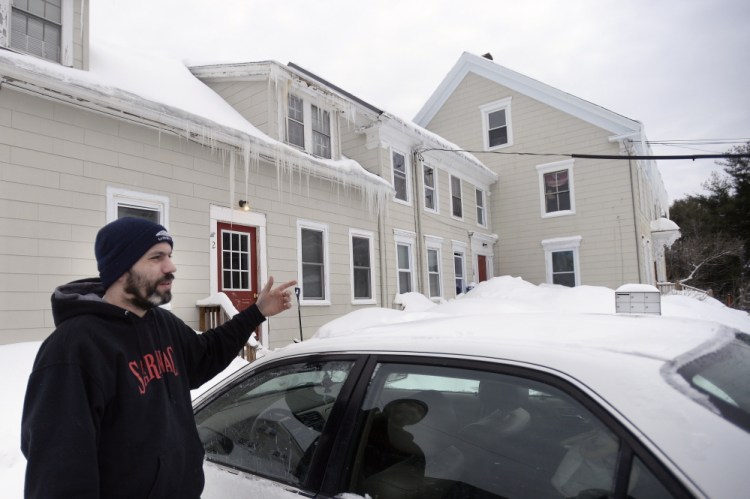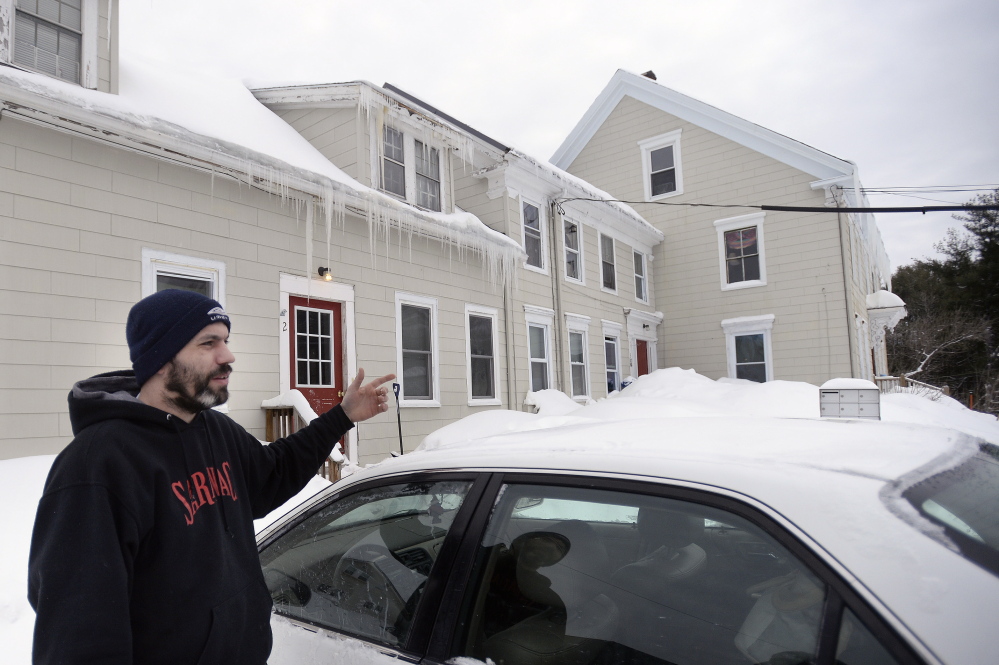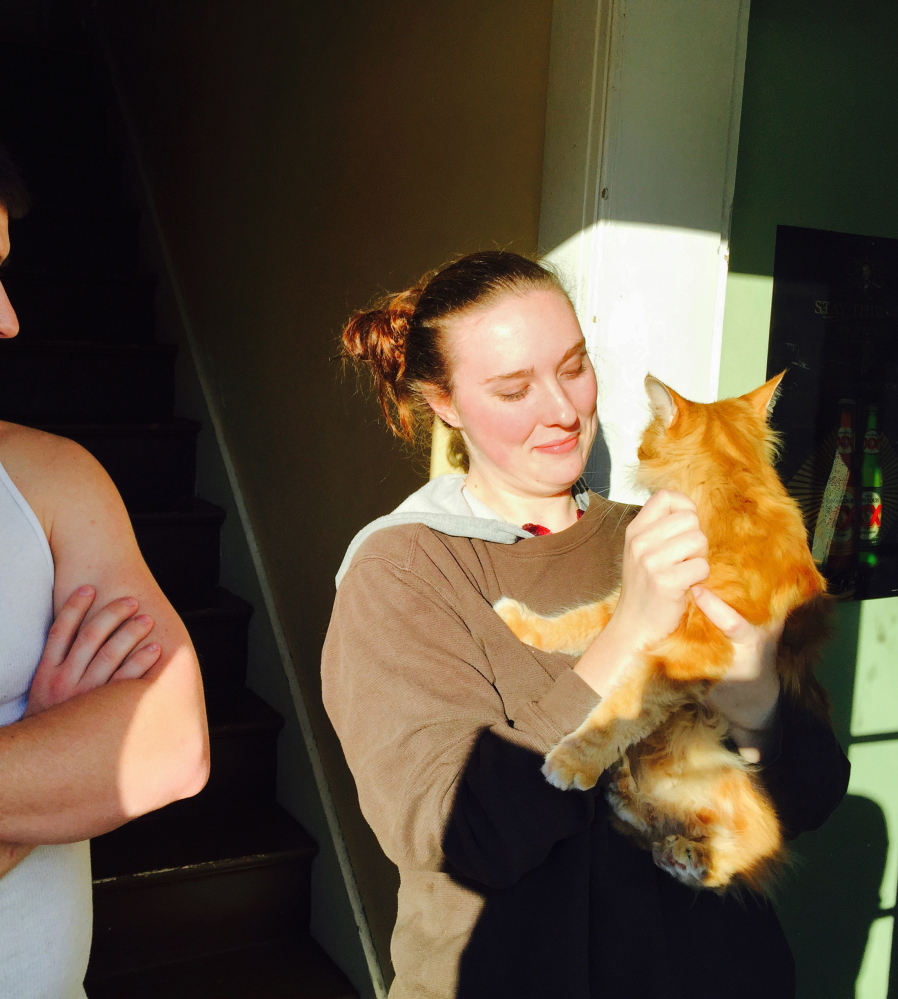GORHAM — The owners of an apartment building where tenants suffered carbon monoxide poisoning Monday were notified in March after a town inspection that the apartments had safety code violations, including no carbon monoxide detectors.
Six residents of 147 Plummer Road, a six-unit apartment building in the rural northern part of town, were taken by ambulance to the hospital for treatment Monday afternoon. They were released later that night, and four others were examined at the scene. Some of the victims taken to the hospital were children, including a 16-year-old girl and a toddler, residents said.
Firefighters found levels of the colorless, odorless gas that were three times what would trigger a carbon monoxide alarm and high enough to be dangerous with prolonged exposure.
“There’s no question it could have ended up in multiple fatalities,” said Gorham Fire Chief Robert Lefebvre.
Lefebvre ordered the building shut down Monday night until the owners met basic life-safety code requirements that include having carbon monoxide detectors, working smoke detectors and emergency exits cleared of snow. Four of the apartments had no working smoke detectors, he said. The American Red Cross in Maine made arrangements for six residents to spend Monday night in a local hotel.
The building’s owners, Donna and Peter Bolling of Cape Elizabeth, met with fire officials and made improvements Monday night and Tuesday so that residents could return to their apartments Tuesday afternoon, Lefebvre said.
The Bollings had been issued an official letter from the fire department April 29 requiring them to provide a written plan to bring the apartments up to safety codes.
The letter was six pages long and detailed 19 code violations, including obstructions in the hallways and stairs, broken steps, needed repair work on the fire escape, and the lack of carbon monoxide detectors. Some of the violations, such as the broken step, dated to 2010.
The town gave the Bollings 30 days to respond to the violations with a correction plan, but did not follow up when the owners did not respond.
LIMITED RESOURCES FOR INSPECTIONS
Town Manager David Cole said it was matter of resources and priorities, a predicament that many town managers and department heads have faced.
Lefebvre said his part-time fire inspector’s hours were cut from 30 a week to 15 about four years ago, at the same time other departments also were enduring cuts. He and his deputy chief also perform inspections, Lefebvre said. The inspectors do all new commercial and multifamily buildings, routine inspections of schools and the University of Southern Maine buildings, and try to inspect apartment buildings every two to three years, he said.
According to the warning letter, the Plummer Road building was inspected in 2010, 2012 and 2014.
It’s not clear how the Bollings responded to the violations cited in 2010 and 2012. The 2012 inspection identified eight violations but made no mention of missing smoke or carbon monoxide detectors. Lefebvre said he didn’t know whether that was because the equipment was in place during that inspection.
DISPUTE ON MONOXIDE DETECTORS
A state law that took effect in 2009 requires multifamily buildings to have carbon monoxide detectors in each unit. The law includes civil penalties of $500 per violation if the detectors are not installed within 10 days of a notice of violation.
Donna Bolling, reached by telephone Tuesday afternoon, said the apartments were equipped with carbon monoxide detectors but they had been disconnected by tenants.
“No matter how many times you tell them not to do it, they like them (disconnected),” she said. Bolling declined to comment further but said the violations in the inspection report had been addressed.
Lefebvre disputed Bolling’s comments on the carbon monoxide detectors. There were smoke detectors that had been disabled in some of the apartments, but no carbon monoxide detectors, he said.
In addition, only two of the six apartments had working smoke detectors, Lefebvre said, and emergency exits were blocked by large snow piles. The exhaust for the propane furnace was blocked by snow and the furnace boiler was cracked, even though it had been installed within the past two years, he said.
Many of the listed violations remain, he said.
NO TOWN PLAN TO FINE LANDLORDS
Lefebvre, who consulted Tuesday with investigators from the State Fire Marshal’s Office, said the town does not plan to seek fines against the Bollings because they have been cooperative since Monday’s incident.
“We’re going to meet again over the remaining issues,” the fire chief said. If the owners follow through on a plan to correct deficiencies, they won’t get fined, he said. “Ultimately, the goal is not to fine somebody. The ultimate goal is to get compliance.”
The cracked boiler appears to be the cause of the carbon monoxide leak, Lefebvre said.
State Fire Marshal Joe Thomas said that if snow was blocking the exhaust vent, that would have contributed to the exhaust, containing carbon monoxide, leaking through the crack in the boiler.
NEIGHBOR ALERTED OTHER TENANTS
Residents first noticed symptoms of carbon monoxide poisoning on Friday, Lefebvre said.
Resident Michael Steward said another resident had bought her own carbon monoxide detector. It had been going off intermittently, but she thought it wasn’t working properly, Steward said. Residents said they notified Donna Bolling, who was snowplowing at the apartments during Monday’s storm, and she said her husband would investigate. An hour later – before Peter Bolling arrived – the fire department had been called.
Steward said he was in his living room Monday afternoon when a neighbor stopped by to ask if he had been having headaches.
“I just assumed it was a caffeine headache,” said Steward, who cut back on soda as a New Year’s resolution. “I had a soda to see if it fixed it. It didn’t.”
It became clear, after his neighbor spoke with other tenants, that several others were experiencing the same symptoms, he said.
Steward said they checked the furnace vent and found the air intake blocked by snow but not the exhaust, which he said already had been shoveled out.
“(The neighbor) said, ‘Everybody has got headaches. We’re going to call the fire department,’ ” Steward recalled.
Residents left the building so firefighters could measure levels, he said. Steward, who lives with two roommates who weren’t home at the time, gathered their pets, leaving behind one cat who avoided him, and left.
DIFFERENCES ON BUILDING CONDITION
Firefighters recorded a carbon monoxide level of 107 parts per million, more than three times the acceptable level of 35 parts per million. Rescue workers found that the carbon monoxide level in Steward’s body was 8 parts per million, not over the threshold of 10 parts per million at which they suggest going to the hospital, he said.
Residents said they began having symptoms of nausea and dizziness Friday, Lefebvre said.
“It wasn’t really bad, but it could have been bad,” Steward said.
Some residents said Tuesday that they did not fault the owners.
James Huston said his apartment was unaffected by the carbon monoxide, although his girlfriend’s daughter was taken to the hospital as a precaution. He believes the incident was an accident caused by unusually high snowfall, and that it was blown out of proportion. He said the Bollings do not neglect the property.
Lefebvre, however, was not so casual. He said many local fire officials have been acutely aware of the deaths of six young people in a November fire on Noyes Street in Portland, in a building that violated city codes and had no working smoke detectors.
“If I can avoid having a Noyes Street (incident) in the town of Gorham and I find a building that is in the shape of this one, I’m going to close it down,” Lefebvre said.
FORMER LANDLORDS HAD VIOLATIONS
The property at 147 Plummer Road, called Brookhill Apartments, consists of two separate buildings, one a rambling farmhouse built in 1880 that was converted decades ago into six apartments – before the town adopted zoning or building codes. That was the building that the fire department shut down. A separate building with five units was not affected by the carbon monoxide and was allowed to stay open once the owners installed detectors.
Max Alfiero, a resident of the building that wasn’t affected, said he did have a combined carbon monoxide and smoke detector, but the battery had died and he had not gotten around to replacing it.
The property has had a history of run-ins with the town. In 1988, 1989, 1996 and 2002, before the Bollings bought the property, the town issued letters to the owners alerting them to code violations. Town records show the owners eventually made improvements, in some cases after multiple letters from the town and threats of legal action.
Lefebvre said the town inspected 147 Plummer Road more frequently because of its history.
The Bollings bought the property in 2002 for $370,000, according to assessor records.
Peter and Donna Bolling also own a four-unit apartment building on Brackett Street in Westbrook that has no outstanding code violations, said Rick Gouzie, the city’s code enforcement officer.
Gouzie said the building was last inspected in 2000 and would only be inspected again if there were complaints.
A resident who answered the door at the Westbrook building declined to answer questions Tuesday about whether the apartments were equipped with carbon monoxide detectors.
This story was updated at 8:55 a.m., Feb. 11, to correct spelling of the name of tenant James Huston in the photo caption.
Send questions/comments to the editors.






Success. Please wait for the page to reload. If the page does not reload within 5 seconds, please refresh the page.
Enter your email and password to access comments.
Hi, to comment on stories you must . This profile is in addition to your subscription and website login.
Already have a commenting profile? .
Invalid username/password.
Please check your email to confirm and complete your registration.
Only subscribers are eligible to post comments. Please subscribe or login first for digital access. Here’s why.
Use the form below to reset your password. When you've submitted your account email, we will send an email with a reset code.